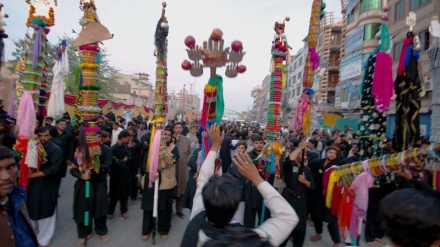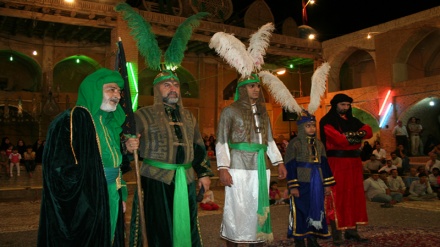Muharram mourning traditions in different lands - 36
Welcome to the 36th part of the series titled “Muharram Mourning Traditions in Different Lands” that we started broadcasting as of October 15 on a daily basis, to commemorate the heartrending tragedy of Karbala, and the martyrdom of Imam Husain (AS), the grandson of Prophet Mohammad (SAWA).
In this series, which delves into the mourning traditions associated with the Immortal Epic of Ashura, we have been focusing on the various norms prevalent in different towns and cities of Iran for commemorating the heartrending tragedy of Karbala, after having dwelt on the history of mourning in different countries of the world for Imam Husain (AS). Today we talk about the tradition of the “Chehel Mimbar” which means Forty Pulpits, or Rostrums or High Seats”.
The Muharram mourning tradition of “Chehel Mimbar” is a ceremony which is held in Gilan province, in northwestern Iran on the Caspian Sea every year. A similar ceremony is also performed in Lorestan province in south-central Iran every Muharram. The ceremony starts on the evening of Tasua or the 9th of Muharram by those individuals or families who have made a vowed to Allah Almighty to make an offering, which in Persian is called “Nazr”. These individuals or families prepare a table, a large bowl full of rice, some dates, a bundle of candles and an empty bowl, placing them near a mosque, or by the side of the main road. That night, mourners carrying 72 dates and 72 candles, one for each of the 72 martyrs of Karbala, stop when they reach a table and light a candle and put it on the table and place a date in the bowl, recite a prayer, and they take a few grains of rice from the table, and move on to the next table by the side of the main street or near a mosque. In the old days, mimbars or pulpits were placed; hence the ceremony is known till this day as “Chehel Mimbar”. In this way mourners visit 40 mimbar, or the high tables, and light 72 candles in memory of the 72 martyrs of Karbala (peace upon him).
That night when the mourners return home, they mix the grains of rice they have collected from the 40 tables (or in the old days 40 mimbars or pulpits) with rice they have at home. The next day, 11th of Moharram, they cook the rice and eat it, and since they have kept their promise (or vow) with God, they believe that by eating the rice, their wishes will come true. A very similar mourning tradition, known as the “Chehel Mimbar, is performed in Lorestan province in central Iran. Also in the city of Birjand in eastern Iran, a similar mourning ceremony known as the “Haft Mimbar” or Seven Pulpits is traditionally performed on the day of Tasua (9th of Muharram).
As we said, Muharram and Ashura have a very special status within the culture of the followers of the Prophet’s Ahl al-Bayt who are also called Shi’a Muslims. Throughout history, many rites and traditions have been observed in the days of Muharram. The cultural heritage of Shi’a Muslims is greatly indebted to the tragedy of Ashura!!
Islam has laid down certain logical rules for “Nazr” (i.e. vowing to make an offering), which is also mentioned in the holy Qur’an. For example a person must be an adult, of sound mind, and must freely choose, and have the intention, to make a "Nazr". Nazr has an individual aspect, but it also has a cultural and a social aspect too. The cultural and social aspects of Nazr are very important. Generally speaking, Nazr can be divided into two groups. One form of Nazr is when a person vows to carry out a particular task, or when a person promises to hold (or to host) a ceremony. The other form of Nazr is when a person promises to feed a gathering of people; so for this type of Nazr food needs to be prepared. Some of the most common, and some of the most important types of Nazr during the mourning month of Muharram are as follows: Nazr to usher in the month of Muharram, Alam or Flag/Standard Nazr, Palm Tree Nazr, Candle Nazr, and Food Nazr. Let us now briefly examine some of them.
As Muharram approaches, many people pledge to the Almighty to take part in cleaning of their local mosque or Husseiniyeh. To usher in Muharram, mosques and Husseiniyehs are thoroughly washed and cleansed, all carpets are cleansed, and the whole place is draped in black in preparation for Muharram mourning. Some people vow to carry the Alam, that is the Flag or Standard of mourning on their shoulders, and this type of Nazr is also very common.
In candle Nazr, some people vow to provide all the candles lit for the Muharram mourning ceremonies, particularly on the evening of 10th of Muharram, known as tragic night or Shaam-e-Gharibaan, of which we explained in our previous episodes. In Palm Tree Nazr, some people, often carpenters, orchard owners or farmers, pledge to provide the "palm Tree" used in the Muharram mourning ceremonies, and often women vow to provide the decorations for the palm tree.
MD/AS/ME


